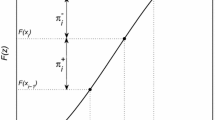Abstract
The probability of selecting a population element under line intersect sampling depends on the width of the particle in the direction perpendicular to the transect, as is well known. The consequence of this when using ell-shaped transects rather than straight-line transects are explicated, and modifications that preserve design-unbiasedness of Kaiser's (1983) conditional and unconditional estimators are presented. A case against treating multiple intersections as multiple probabilistic events is argued on the basis, also, of preserving design-unbiased estimation.
Similar content being viewed by others
References
Battles, J.J., Dushoff, J.G., and Fahey, T.J. (1996) Line intersect sampling of forest canopy gaps. Forest Science, 42, 131–8.
Beckmann, P. (1971) A History of π, St. Martin's Press, New York.
Buck, R.C. (1965) Advanced Calculus, McGraw-Hill Book Company, New York, p. 527.
Canfield, R.H. (1941) Application of the line interception method in sampling range vegetation. Journal of Forestry, 39, 34–40.
Cochran, W.G. (1977) Sampling Techniques, Wiley, New York.
Delisle, P.D., Woodard, M.P., Titus, S.J., and Johnson, A.F. (1988) Sample size and variability of fuel weight estimates in natural stands of lodgepole pine. Canadian Journal of Forest Research, 18, 649–52.
deVries, P.G. and Van Eijnsbergen, A.C. (1973) Line Intersect Sampling Over Populations of Arbitrarily Shaped Elements, Mededelingen Lanbrouwhogeschool, Wageningen, The Netherlands, pp. 73–19.
deVries, P.G. (1979) Line intersect sampling: statistical theory, applications, and suggestions for extended use in ecological inventory. In Sampling Biological Populations, R.M. Cormack, G.P. Patil, and D.S. Robson (eds), International Co-operative Publishing House, Fairland, Maryland, pp. 1–70.
Dorazio, R.M. (1999) Design-based and model-based inference in surveys of freshwater mollusks. Journal of the North American Benthological Society, 18, 118–31.
Eberhardt, L.L. (1978) Transect methods for population studies. Journal of Wildlife Management, 42, 1–31.
Gregoire, T.G., Valentine, H.T., and Furnival, G.M. (1993) Estimation of bole surface area and bark volume with Monte Carlo methods. Biometrics, 49, 653–60.
Gregoire, T.G. and Monkevich, N.S. (1994) The reflection method of line intercept sampling to eliminate boundary bias. Environmental and Ecological Statistics, 1, 219–26.
Gregoire, T.G. (1998) Design-based and model-based inference in survey sampling: appreciating the difference. Canadian Journal of Forest Research, 28, 1429–47.
Hazard, J.W. and Pickford, S.G. (1986) Simulation studies on line intersect sampling of forest residue, part II. Forest Science, 32, 447–70.
Hedayat, A.S. and Sinha, B.K. (1991) Design and Inference in Finite Population Sampling, Wiley, New York.
Kaiser, L. (1983) Unbiased estimation in line-interception sampling. Biometrics, 39, 965–76.
Lucas, H.A. and Seber, G.A.F. (1977) Estimating coverage and particle density with the line intercept method. Biometrika, 64, 618–22.
Marshall, P.L., Davis, G., and LeMay, V.M. (2000) Using line intersect sampling for coarse woody debris. Tecnical Report TR-003, Research Section, Vancouver Forest Region, British Columbia Ministry of Forests.
Matérn, B. (1956) On the geometry of the cross-section of a stem. Meddelanden Från Statens Skogforskningsinstitut, Band 46Nr (11), pp. 28.
Matérn, B. (1964) A method of estimating the total length of roads by means of a line survey. Studia Forestalia Suecica, 185, 68–70.
McIntyre, G.A. (1953) Estimation of plant density using line transects. Journal of Ecology, 41, 319–30.
Pielou, E.C. (1975) Line intersect sampling. In Encyclopedia of Statistical Sciences, S. Kotz and N.L. Johnson (eds.), 5, Wiley, New York, pp. 70–74.
Ringvall, A. and G. Ståhl. (1999) Field aspects of line intersect sampling for assessing coarse woody debris. Forest Ecology and Management, 119, 163–70.
Runkle, J. (1985) Comparison of methods for determining fraction of land area in treefall gaps. Forest Science, 31, 15–19.
Runkle, J. (1992) Guidelines and sample protocol for sampling forest gaps. U.S.D.A. Forest Service PNW-GTR-283. Portland, Oregon: U.S.D.A. Forest Service, Pacific Northwest Research Station, p. 44.
Särndal, C-E., Swensson, B., and Wretman, J. (1992) Model Assisted Survey Sampling, Springer-Verlag, New York.
Valentine, H.T., Gove, J.H., and Gregoire, T.G. (2001) Monte Carlo approaches to sampling forested tracts with lines or points. Canadian Journal of Forest Research, 31, 1410–24.
Warren, W.G. and Olsen, P.F. (1964) A line intersect technique for assessing logging waste. Forest Science, 10, 267–76.
Author information
Authors and Affiliations
Rights and permissions
About this article
Cite this article
Gregoire, T.G., Valentine, H.T. Line intersect sampling: Ell-shaped transects and multiple intersections. Environmental and Ecological Statistics 10, 263–279 (2003). https://doi.org/10.1023/A:1023698813989
Issue Date:
DOI: https://doi.org/10.1023/A:1023698813989




